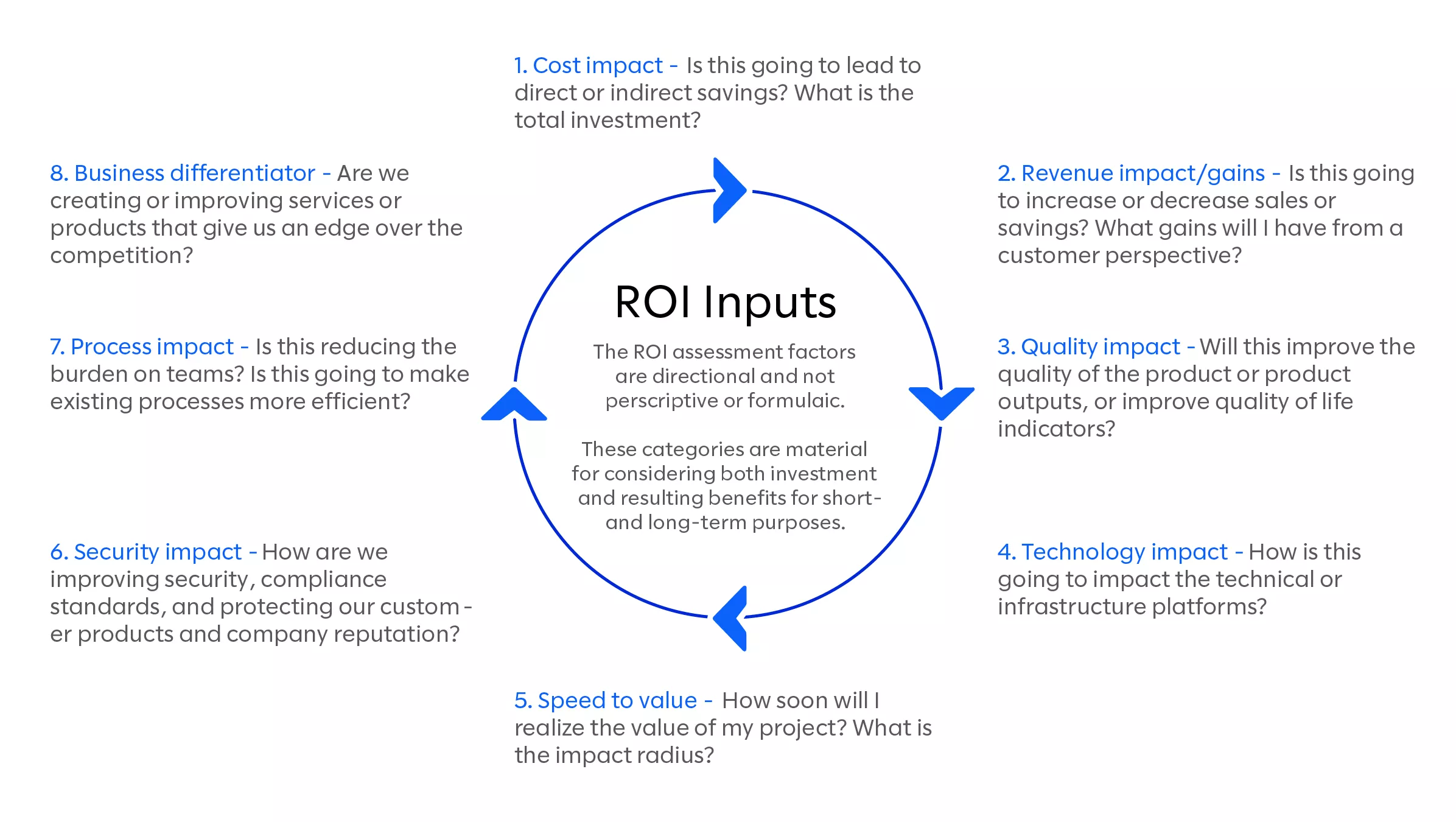ROI in AI: Measure value to deliver value

When it comes to artificial intelligence (AI), where discovery and experimentation are central to the development of any use case worth its salt, concerns of ROI play a central role in determining where organizations should invest their time and resources. ROI can frequently be harder to calculate for data science use cases, given the widespread and sometimes nebulous nature of impacts. This makes it very important to leverage an ROI analysis at the earliest opportunity to achieve clarity in how best to prioritize high-value use cases and products.
It’s important to understand that calculating ROI is not an all-or-nothing approach. Some use cases can be justified by simply looking at obvious efficiencies gained, while others require a more robust business case to justify an investment.
Affirm value through intelligent prioritization
Since most AI systems and products are founded on substantial bodies of data garnered from a variety of sources, the data or device supply chains can be long, the infrastructure and resource overheads high, and the outputs not always expected. In this sense, it’s extremely important to evaluate potential or clear benefits in a transparent and scalable way. The earlier you can make a comprehensive estimation of costs and benefits, the more compelling your argument will be to prioritize a use case. Effective prioritization methods become more important as an organization’s product portfolio and user base broadens.
Build responsible AI
As AI systems increase in ubiquity, efficiency, competency, and power, you should be actively anticipating both the direct and indirect impacts of all your AI implementations. A comprehensive ROI assessment should account for both tangible and intangible impacts. ‘Soft’ factors—such as impact to the environment or your company’s reputation—could be just as important as ‘hard’ factors, such as increased infrastructure costs or improved revenue.
Inherent to the notion of responsible AI is understanding the ‘machine footprint’ that results from machine intelligence, and a comprehensive ROI analysis can help you achieve this understanding.
Why is calculating ROI for AI hard?
The complexity and plethora of factors underlying any AI project make it difficult to assess comprehensive value. While the first step is the hardest, the subsequent assessment becomes clearer as teams achieve understanding, alignment, and synergy. Common questions you may be asking as you figure out how to get started include:
- To understand key associated costs and benefits, where do we start?
- Should we include ‘soft’ benefits? How do we measure them?
- Do we need a different approach for short-term and long-term benefits?
Getting started
The best place to start is in the ideation phase of a use case, but you can just as efficiently calculate ROI during later phases of use case development. An early ROI calculation does help you efficiently prioritize and invest your resources, but you can certainly do so later as well.
Our framework provides multiple entry points to begin ROI estimation, from the conception of a use case through to its execution and maintenance in the real world.
ROI calculations can be iterative and incremental as you acquire insights and expertise. Your goal should be a comprehensive estimation of costs and benefits that’s applied consistently across an organization or portfolio, and in time evolving from forecast to actual ROI.
For example, a use case at the point of conception may have a perceived value that’s founded more on heuristics and intelligent guesswork than hard data. Many great products, especially bleeding-edge ones, start out with a great idea and a good feeling. If available data is limited, it’s important to clearly document any assumptions that underly your ROI estimates.
In short, if ROI has never been calculated, it’s a good time to start. If it’s been partially calculated, it’s a good time to refine it. If it’s been inaccurately calculated it, it’s a good time to revise the approach. And if you’re unsure where to start, then our framework offers a good place to begin.
Diving into the details
In general, ROI tends to be treated in the following ways:
- Traditional ROI: The majority of benefits are calculated in clear dollar amounts. ‘Hard’ and ‘soft’ costs and benefits are taken into account.
- Non-traditional ROI: Dollar returns may not be the only way to measure benefits. This may be the case for brand-new or disruptive products with business benefits that go beyond basic cost reduction or revenue gains. Measurement can be hardened through iteration, consensus, and results. Short-term and long-term ROI may need to be calculated differently.
- Hybrid ROI: Some benefits are easier to measure monetarily than others, so a combination of traditional and non-traditional approaches are used. Consistent units of measurement must be used to ensure returns are measured accurately across use case and products, and through time. Short-term and long-term ROI may need to be calculated differently
- Uncalculated ROI: Benefits and costs aren’t estimated in any measurable, repeatable, or uniform way. Decisions on ROI calculation and measurement must be made.
Understand, define, align, and visualize your ROI
Your ROI assessment could start with a process that includes the following steps:
- Understand the comprehensive costs and benefits of your initiative. This is where you begin to determine clear benefits that are easier to calculate, and more intangible ones that could be harder.
- Define your ROI measurement approach. Include units of measurements for all the costs and benefits that you’ll include in your calculation.
- Align your ROI approach across your portfolio and to your business KPIs to make sure you’re delivering targeted business value.
- Visualize your ROI calculations on a dashboard to facilitate prioritization and decision-making across your portfolio of use cases and products.
As you refine your approach, your ROI calculations will increase in precision. An ROI calculation is legitimate and credible only when it’s put into context. How does the ROI compare across use cases? How does realized ROI compare to projected ROI? The power of visualizing forecast and actual ROI across a portfolio of products cannot be underestimated.
Identifying key ROI inputs
Our framework creates a 360-degree view into both tangible and intangible costs and benefits via eight primary assessment categories. A uniform and consistent valuation model can be used to compare use cases by understanding and defining value criteria and units of measurement.
It’s important to consider all of the categories in our framework, eliminating those that have less or no relevance.
Let’s break down these categories to better understand how each applies to an ROI analysis. Note that there can be varying degrees of overlap between categories. They’re not mutually exclusive, and each represents a source of both costs and benefits. The idea is to use each of the categories to frame ways in which AI can incur both costs and benefits. Use the details as guidance, not a checklist.

1. Cost impact
Cost impacts are a foundational component in an ROI analysis. There are multiple elements that could incur or reduce costs. For example, your use case could increase or decrease infrastructure or human resource costs, or costs of data acquisition and software licenses could go up.
2. Revenue impact
Your ROI use case needs to have a clear benefit that will translate into direct or indirect revenue impacts. Will you be able to increase revenue through new customers or an increase in customer lifetime value? Could there be an unforeseen cost or negative effect? Are other systems being benefited or impacted in other ways by your AI solution?
3. Quality impact
Will your existing products and services experience qualitative feature or functional improvements? New products might need to meet or exceed existing standards. You’ll want to consider quality as a key determinant in the ROI analysis, whether it’s reducing existing pain points or vulnerabilities, improving overall experience, or creating net-new beneficial effects.
4. Technology impact
Aside from upfront investments required in the new technology, other factors to consider are how legacy technology costs will change and what the recurring future technology costs will be. Is the existing or new AI solution a good fit for the technology it’s built on? Are there ways to do more with less?
5. Speed to value
In certain situations, the go-to-market time is the biggest priority and biggest value consideration. Does your AI solution fall into this category? If so, what are some of the inputs you should consider to determine the value of such a solution? For example, how much are you willing to invest to outstrip a competitor? Should you speed up your delivery to satisfy a regulatory requirement or take advantage of ideal market conditions?
6. Security impact
If your use case is going to address key security risks or threats, have you calculated the benefits of threat aversion or improved privacy for your clients? You can achieve significant cost savings and benefits through security improvements. You can also incur risks and threats through improper security considerations. Will you avoid costly penalties? Will you significantly reduce risk through enhanced measures?
7. Process impact
If your use case was planned to improve processes, identify which ones were optimized and by how much. Are there clear time or resource savings? Will some of your compute processes be improved? Will your customers have a better shopping experience?
8. Business differentiator
AI innovations can give an organization a competitive edge and create subtle or significant advantages. In such cases, your benefits might pay out over a longer timeframe. Are you creating a new service or product that’s the first of its kind? Are you substantially improving your brand or reputation?
There's no wrong time to begin
It should be clear by now that estimating the ROI of your AI is not an all-or-nothing approach; there’s no wrong time to understand the value of your AI investments. But it’s something that should be done for every AI solution. Calculating and monitoring the value of your AI solutions is critical to solidifying your AI portfolio and laying a foundation for efficient, powerful, and responsible AI.


